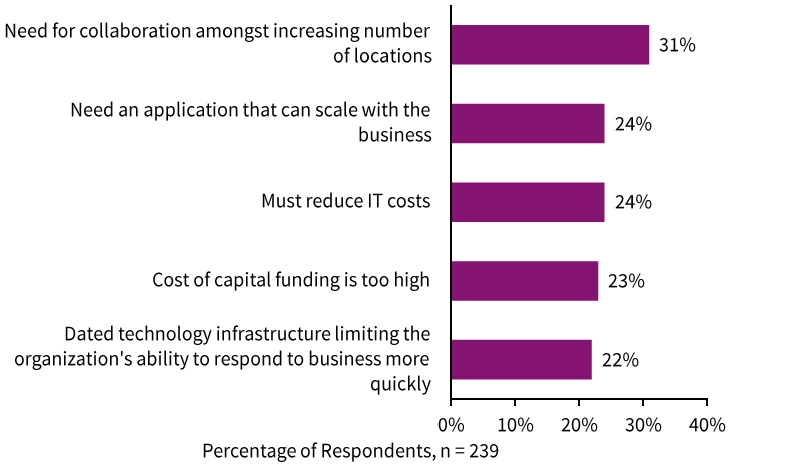Migrating to Cloud Enterprise Resource Planning?

A high percentage of organizations are considering a cloud solution for their next ERP deployment in comparison to the on-premise model, but just because cloud works for other businesses does it mean it’s the right fit for yours?
There has been a gradual shift from on-premise Enterprise Resource Planning (ERP) solutions being the most common ERP deployment, to the rise and growing popularity of cloud ERP deployments.
For the first time in ERP history, ‘a higher percentage of organizations are considering a cloud solution for their next ERP deployment in comparison to the on-premise model,‘ according to a recent study conducted by Aberdeen.
Even so, we know you have the best interest of your organization in mind, and just because cloud works for other businesses doesn’t mean it’s the right fit for yours. Or does it?
There are reasons why so many successful businesses are migrating to cloud, so let’s dig into those and in turn, see if the benefits would apply to your company.
Top Reasons why Leading Organizations Migrate to the Cloud
Since 2009, there’s been a 30% decrease in organizations reporting even being willing to consider an on-premise solution, and at the same time, from 2009 to 2016, the percentage of organizations that would consider a cloud solution for ERP has increased from 23% to 59%.
So why are organizations suddenly so interested in the cloud? The top reasons, aka pain points, reported by Aberdeen after surveying business about their ERP and why they switched to cloud including:
- Ability to standardize onto a single system across multiple entities – 35%
- Need for collaboration amongst increasing number of locations – 29%
- Need an application that can scale with the business – 27%
- Need to reduce IT costs – 23%
- Cost of capital funding is too high – 19%
- Data technology infrastructure limiting the organizations' ability to respond to business more quickly – 17%
When looking at all the reasons collectively there are three common threads: growth, the ability to operate globally with ease, and cost.
As organizations get larger and expand into multiple entities, especially when there are global locations, the need for a unified system that can centralize data and communications becomes increasingly valuable.
Scaling an on-premise solution to meet the complex requirements of a growing (and possibly global) organization can become both difficult and costly, compared to working with cloud solutions which directly resolve the pain points outlined above.
As described by Aberdeen: ‘It’s time to migrate to cloud ERP. If your organization waits, it will be unprepared for the new business environment.’
Business Drivers that Impact Cloud Decisions
Benefits for Migrating to Cloud
Real-Time and Mobile Access to Data
Data is the backbone of every organization and since they can be accessed via the internet, cloud ERPs are twice as likely as on-premise ERPs to have real-time visibility of data. This is essential because it enables your organization to collaborate across departments and locations without an information lag and make educated decisions based on the accurate and current information.
Furthermore, since the majority of cloud ERPs are compatible with mobile devices, you’ll benefit from access to your data whenever and wherever you are, as long as you have access to the internet. For example, while visiting a client you can use your mobile device to access your cloud ERP and check your current stock levels without having to contact someone in the warehouse or go back to your workstation.
Scalability
As organizations grow, their processes and software requirements change. It’s a natural part of the business life cycle but it’s essential to have a solution that can accommodate those changes. One of the most prominent pain points for businesses using on-premise ERP’s is the time and effort involved in making changes to their solution. Organizations with a cloud ERP are 48% more likely to have the ability to make changes to their ERP quickly and having the ability to make changes to your ERP faster will help minimize process inefficiencies, data inaccuracies and the headache that results when your ERP can’t achieve or support what you need it to.
Training
In an age where everything surrounds the internet, people want to be self-sufficient as much as they can. Organizations with cloud ERP are 69% more likely to have embedded online support and training within their solutions, which enable your employees to learn and resolve issues proactively, without having to seek out assistance from a business partner for every little issue. This not only reduces cost but also ensures that your processes can continue running smoothly with minimal disruptions.
Automatic Updates
Cloud ERP deployments typically make updating software easier and less complex which is beneficial because organizations that maintain the most recent version of their software see a “30% greater improvement in profitability stemming from their solution in comparison to those on an older version of their solution.” Depending on the deployment, updates for cloud ERPs are often handled automatically by the ERP vendor, which ensures that organizations are always operating on an updated system.
Staying up-to-date with the newest versions of your cloud ERP allows you to benefit from the latest best practices, regulations and technological advancements however with that said, software updates shouldn’t be accepted blindly. It’s always preferable to choose a cloud ERP deployment that gives you and your ERP partner the option to evaluate new versions before updating to ensure that the update will benefit your organization and won’t harm any customizations that may exist in your set-up.
There is plentiful evidence that supports the benefits of Cloud ERP, including real-time and mobile access to data, self-sufficient training and the ability to make changes to your software facing less complexity, enabling you to scale your software as needed and run the most recent updates. However every business is unique in its design and requirements so working collaboratively with an ERP business partner will help you determine if a cloud ERP deployment is the best fit for your business, and if so which one.
While there is nothing fundamentally wrong with on-premise ERP solutions, the industry is being built to surround and accommodate cloud so it’s important to pay attention to changes in the industry and take action to keep your business software relevant.
Source: The Answer Company
Related Article: Cloud Enterprise Resource Planning: 3 Reasons Why Cloud ERP is Misunderstood
Article Topics
Aberdeen Group News & Resources
Managing Risk in Your S&OP/Integrated Business Planning Process Migrating to Cloud Enterprise Resource Planning? Top Performers Know It’s Time to Migrate to Cloud Enterprise Resource Planning The Evolution of the Automotive Supply Chain Analyst Report: The Benefits of Cloud ERP New Global Trade Management: Connecting Upstream Decisions to Improve Downstream Execution Leveraging Global Trade Management (GTM) for Frictionless Ecommerce More Aberdeen GroupLatest in Supply Chain
Amazon Logistics’ Growth Shakes Up Shipping Industry in 2023 Spotlight Startup: Cart.com Walmart and Swisslog Expand Partnership with New Texas Facility Nissan Channels Tesla With Its Latest Manufacturing Process Taking Stock of Today’s Robotics Market and What the Future Holds U.S. Manufacturing Gains Momentum After Another Strong Month Biden Gives Samsung $6.4 Billion For Texas Semiconductor Plants More Supply Chain















